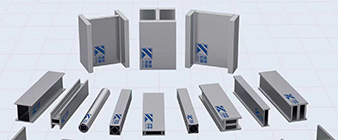Corrosion resistance:
EN 1.4401 stainless steel offers enhanced corrosion resistance compared to standard 316 stainless steel.
The higher chromium and molybdenum content in EN 1.4401 increases its resistance to spots, crevices and general corrosion, especially in chloride-containing environments.
This makes EN 1.4401 a better choice for applications in marine, coastal and highly corrosive industrial environments.
Chemical Resistance:
The increased alloy content in EN 1.4401 stainless steel increases resistance to a wider range of chemicals, acids and alkalis.
This makes it suitable for use in chemical processing equipment, pharmaceutical manufacturing, and other applications involving exposure to aggressive chemicals.
Mechanical Properties:
EN 1.4401 stainless steel maintains excellent mechanical properties, including high tensile and yield strengths and good ductility.
The material’s strength-to-weight ratio makes it suitable for structural applications where it could provide a corrosion-resistant alternative to carbon steel.
Solderability:
EN 1.4401 stainless steel has better weldability than standard 316 stainless steel.
The lower carbon content in EN 1.4401 helps reduce the risk of carbide precipitation and maintains corrosion resistance in the heat-resistant areas of the material during welding.
Thermal Performance:
EN 1.4401 stainless steel exhibits good thermal stability and maintains its mechanical and corrosive properties at low and high temperatures.
This makes it suitable for applications involving exposure to extreme temperatures, such as the petrochemical, aerospace and cryogenic industries.
The appeal of aesthetics:
The bright, uniform appearance of EN 1.4401 stainless steel makes it a popular choice for architectural and decorative applications, where its corrosion resistance and durability are also valued.
Enhanced corrosion and chemical resistance, as well as maintained mechanical properties and weldability, make EN 1.4401 stainless steel the first choice in applications where excellence in aggressive environments is required. However, this increased performance comes at a higher cost than standard 316 stainless steel.
-
 2024-9-27 C22 / 2.4602 Nickel-Based Alloy Structural Profiles: Beams and Columns
2024-9-27 C22 / 2.4602 Nickel-Based Alloy Structural Profiles: Beams and Columns -
 2024-9-25 Stainless Steel 430/1.4016 Structural Profiles
2024-9-25 Stainless Steel 430/1.4016 Structural Profiles -
 2024-9-24 310S stainless steel hollow structural Sections
2024-9-24 310S stainless steel hollow structural Sections -
 2024-9-15 Weathering steel H-shaped steel
2024-9-15 Weathering steel H-shaped steel -
 2024-9-20 What are some of the common structural elements or members fabricated using 1.4404 stainless steel profiles in civil projects?
2024-9-20 What are some of the common structural elements or members fabricated using 1.4404 stainless steel profiles in civil projects? -
 2024-9-24 ASTM A514 Structural Steel Section
2024-9-24 ASTM A514 Structural Steel Section -
 2024-9-24 S690 Structural Section-Universal Bearing Piles
2024-9-24 S690 Structural Section-Universal Bearing Piles



